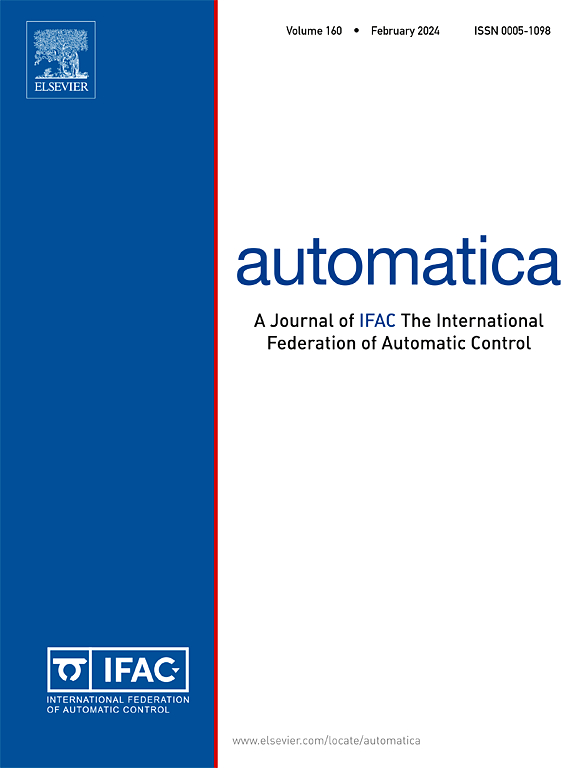Backstepping for partial differential equations: A survey
IF 5.9
2区 计算机科学
Q1 AUTOMATION & CONTROL SYSTEMS
引用次数: 0
Abstract
Systems modeled by partial differential equations (PDEs) are at least as ubiquitous as those by nature finite-dimensional and modeled by ordinary differential equations (ODEs). And yet, systematic and readily usable methodologies, for such a significant portion of real systems, have been historically scarce. Around the year 2000, the backstepping approach to PDE control began to offer not only a less abstract alternative to PDE control techniques replicating optimal and spectrum assignment techniques of the 1960s, but also enabled the methodologies of adaptive and nonlinear control, matured in the 1980s and 1990s, to be extended from ODEs to PDEs, allowing feedback synthesis for systems that are uncertain, nonlinear, and infinite-dimensional. The PDE backstepping literature has since grown to hundreds of papers and nearly a dozen books. This survey aims to facilitate the entry into this thriving area of overwhelming size and topical diversity. Designs of controllers and observers, for parabolic, hyperbolic, and other classes of PDEs, in one or more dimensions, with nonlinear, adaptive, sampled-data, and event-triggered extensions, are covered in the survey. The lifeblood of control are technology and physics. The survey places a particular emphasis on applications that have motivated the development of the theory and which have benefited from the theory and designs: flows, flexible structures, materials, thermal and chemically reacting dynamics, energy (from oil drilling to batteries and magnetic confinement fusion), and vehicles.
偏微分方程的反演:综述
由偏微分方程(PDEs)建模的系统至少与那些本质上是有限维的、由常微分方程(ode)建模的系统一样普遍。然而,对于实际系统中如此重要的一部分来说,系统的和易于使用的方法在历史上是稀缺的。2000年前后,PDE控制的回溯方法不仅提供了一种不那么抽象的PDE控制技术,复制了20世纪60年代的最优和频谱分配技术,而且使20世纪80年代和90年代成熟的自适应和非线性控制方法从ode扩展到PDE,允许对不确定、非线性和无限维的系统进行反馈综合。关于PDE回溯的文献已经发展到数百篇论文和近12本书。这项调查旨在促进进入这个规模庞大、主题多样的繁荣领域。控制器和观测器的设计,为抛物线,双曲,和其他类的偏微分方程,在一个或多个维度,具有非线性,自适应,采样数据,和事件触发的扩展,涵盖在调查。控制的命脉是技术和物理。该调查特别强调了推动理论发展并从理论和设计中受益的应用:流动、柔性结构、材料、热和化学反应动力学、能源(从石油钻探到电池和磁约束聚变)和车辆。
本文章由计算机程序翻译,如有差异,请以英文原文为准。
求助全文
约1分钟内获得全文
求助全文
来源期刊

Automatica
工程技术-工程:电子与电气
CiteScore
10.70
自引率
7.80%
发文量
617
审稿时长
5 months
期刊介绍:
Automatica is a leading archival publication in the field of systems and control. The field encompasses today a broad set of areas and topics, and is thriving not only within itself but also in terms of its impact on other fields, such as communications, computers, biology, energy and economics. Since its inception in 1963, Automatica has kept abreast with the evolution of the field over the years, and has emerged as a leading publication driving the trends in the field.
After being founded in 1963, Automatica became a journal of the International Federation of Automatic Control (IFAC) in 1969. It features a characteristic blend of theoretical and applied papers of archival, lasting value, reporting cutting edge research results by authors across the globe. It features articles in distinct categories, including regular, brief and survey papers, technical communiqués, correspondence items, as well as reviews on published books of interest to the readership. It occasionally publishes special issues on emerging new topics or established mature topics of interest to a broad audience.
Automatica solicits original high-quality contributions in all the categories listed above, and in all areas of systems and control interpreted in a broad sense and evolving constantly. They may be submitted directly to a subject editor or to the Editor-in-Chief if not sure about the subject area. Editorial procedures in place assure careful, fair, and prompt handling of all submitted articles. Accepted papers appear in the journal in the shortest time feasible given production time constraints.
 求助内容:
求助内容: 应助结果提醒方式:
应助结果提醒方式:


